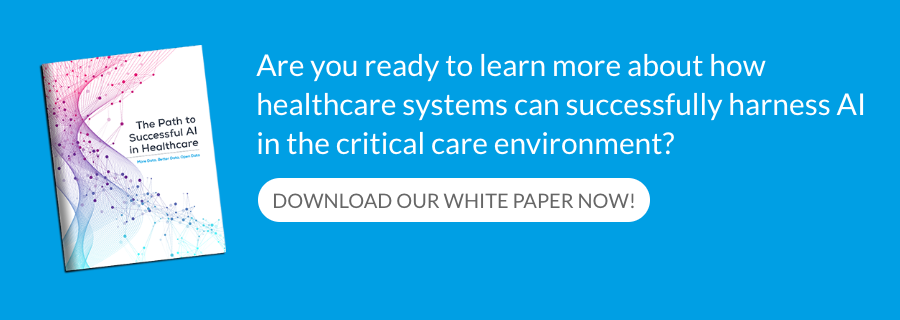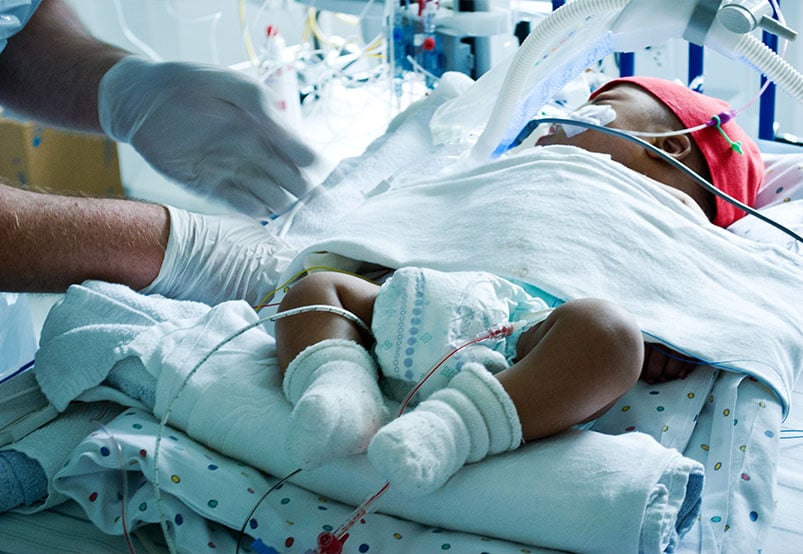
Dr. Dan Berkowitz shares his vision for data-driven care at UAB
Dan Berkowitz, M.D., has always been hopeful for a healthcare future that is driven by data. To an online audience of healthcare professionals across the country in a recent BrightTalk webcast, he laughed at a memory of himself trying to use the tools he had in years past to harness data he could use to help patients. Dr. Berkowitz served as a panelist in the discussion, which centered on laying the groundwork for patient-centered AI at scale.
“I was one of those guys who was rolling out carts with analog digital converters, plugging in these plugs to the back of devices! It was clunky and it was difficult to re-access the data,” he said. The technology that exists now is much more accessible, he stressed, for leveraging patient-specific data to enable machine learning and AI at scale for healthcare organizations.
Dr. Berkowitz is the chair of the Department of Anesthesiology and Perioperative Medicine at the University of Alabama at Birmingham (UAB) School of Medicine. UAB is the largest academic center in AL and the fifth-largest academic public academic hospital in the country. Dr. Berkowitz sees the value in technology not only for tomorrow’s patients, but also those he and his colleagues are treating today.
“My vision is integration of data — for the whole perioperative journey to utilize data not only for risk stratification of patients in pre-operative stages of their journey, but also the development and utilization of tools for precision medicine management of patients in the operating room and in the ICU for predictive modeling,” Dr. Berkowitz said.
He emphasized the importance of creating value in a sophisticated way by leveraging the data from bedside devices, and integrating it so that it’s used by physicians, who can see the potential for positive impact on clinical care. While Dr. Berkowitz sees first-hand that critical care specialists and anesthesiologists would benefit greatly from this data, he feels that all clinicians would be able to utilize it in important ways.
Emma Fauss, Ph.D., M.B.A., co-founder and CEO of MIC, was also a panelist on the webcast and echoed that sentiment as she recalled making a visit to the lab of MIC’s co-founder, Craig Rusin, Ph.D. He was creating ways to access data that had previously only been locked away in devices that speak only proprietary languages and had no interoperability.
“I saw this line of physicians standing outside his doorway!” Dr. Fauss remembered. She asked Dr. Rusin why they were all there, and learned that they were desperate to access data from their own patients’ bedside devices. Dr. Fauss saw how important this data was to these busy physicians, visually demonstrating to her the undercurrent that had been growing ever louder as patient monitoring had advanced while clinical tools to access this information had not kept pace. “If you’re not on the front lines, you often are not aware and don’t necessarily recognize the gaps in data that a lot of people taking care of patients every day have,” Dr. Fauss said.
Remote Monitoring
Drs. Rusin and Fauss took it on themselves to create a solution that would give access to all patient data, anytime, anywhere to physicians and other clinicians like this that were lining up outside a doorway. Their journey began with changing the very dynamics of patient monitoring through software. By adding a web-based application layer to a data aggregation engine, patient data that is typically thrown away is actually unlocked. This means that all members of the healthcare team can perform clinical surveillance and remote monitoring from disparate medical devices, anytime, anywhere. With this capability, physicians, researchers and data scientists like Dr. Berkowitz don’t have to roll carts around to get data for research: Instead, they can develop and deploy real-time, patient-specific analytics at scale.
UAB is one of the many sites across the nation utilizing the technology to help battle today’s pandemic and start leveraging AI to get ahead of deterioration and risk. “The ability of new technology to access data remotely is important,” said Dr. Berkowitz, who is leading the charge at his institution. “In the year of COVID, if the monitors are in the patient rooms, how can information be observed and seen in a remote location?”
Accessing that information without compounding risk for practitioners or needlessly using PPE, and allowing clinicians to define problems and provide recommendations from a remote location, is essential. “These are some of the problems that occur in the real clinical world,” Dr. Berkowitz added.
Dangers of Disjointed Data
Outside of battling the pandemic, Dr. Berkowitz illustrated the very real challenges physicians face in accessing data that helps provide decision support as they determine potentially life-saving care.
“The issue is the disjointedness of the data, the multiple platforms that are necessary for providers to access data in order to integrate it, and the fact that information downloaded onto sheets, tables, whatever formats you can use are intermittent. They don’t give you continuous assessment,” he said. “That can be challenging when a patient has an event, and you don’t know what preceded that event, whether it’s acute hypoxia, arrhythmia, or whatever. You can’t analyze that in a sophisticated way to know what occurred.”
Patients suffer from two types of deterioration in a critical care setting, Dr. Fauss explained. One is rapid, acute deterioration that can happen quickly, like a code event. “The care team deals with that in the immediate timeframe, but then when you’re trying to go back and understand what happened, an arrhythmia might be missed or not documented, or an arrest event might not have all the data around that,” she said.
The other danger is long-term deterioration that can happen over multiple shifts. “The format in which data is presented [for most hospitals] today lacks the granularity. Long-term deterioration on a ventilator, for example, often isn’t stored or is difficult to pick up, the way data is visualized,” she noted as she emphasized that the clinical impact to this deficit can be life-threatening.
“’Sudden changes’ are the accumulation of small, subtle changes that ultimately lead to a state change in the patient,” Dr. Berkowitz added. “It’s that state change—for example, a patient developing septic shock-- that we would like to determine or predict in advance.”
Precision Physiologic Management of Patients
Emphasizing the possibility that Dr. Berkowitz and other clinicians see in the greater picture of data collection and analysis, he discussed a few of its myriad uses.
“Most importantly, from a physiologic standpoint and a precision standpoint, all patients are different,” he said. “When we think about trying to monitor or keep things like blood pressure constant, we know not everyone is the same.” Using transformed data that provides more insight, clinicians can institute more precision-based therapies.
“A good example is in measuring blood pressure critical for maintaining adequate cerebral perfusion pressure,” Dr. Berkowitz said. “If we can get information about blood pressure and blood flow together, then we can predict what blood pressure is good for that particular patient and can manage that. This is so important for precision physiologic management of patients.”
By storing data and looking at all the physiologic variables recorded in high precision, algorithms can be built that enable clinicians to predict events long before they occur.
“From development of sepsis to low blood pressure, hypertension, and atrial fibrillation, this allows us to intervene,” Dr. Berkowitz said. Hospitals like his are using data to build risk prediction algorithms that will serve as important information as physicians make decisions on patient care.
“Machine learning and AI are all about pattern recognition, training a computer algorithm to recognize things you perhaps can’t see yourself,” Dr. Fauss said. “It enables you to do this at a scale you’ve never done before.”
Hospitals Implementing See Immediate Value
UAB is one of the hospitals that has begun to implement the technology needed to do vendor agnostic remote monitoring, machine learning and AI at scale. Dr. Berkowitz said that Sickbay is deployed in the hospital’s ICU and in the operating rooms, and his goal is to bring it to all care beds.
“We have created a team at UAB that will be able to work with this data,” he said. “We’ve hired a machine learning expert who will look at algorithm development and predictive analytics. The most important thing for us is to demonstrate that we can show improvement in outcome and as such, enhanced value.
“All of these things are ultimately our goal of improving patient care and outcomes, reducing length of hospital stay and preventing events from happening, particularly if we can see them coming a patient’s way,” he said. “I think that’s where we’re headed towards.”
Hospitals implementing technology like Sickbay can see both immediate and long-term benefits, Dr. Fauss said.
“A lot of systems have single use, but we’re essentially allowing a common infrastructure for this data to be leveraged in downstream applications,” she said. “We push our data to web-based interfaces – so from a technical standpoint, it means we’re flexible about embedding our data. We can put it in your EMR or remote workflows without having to disrupt the clinical environment.
Dr. Fauss emphasized that there is much an institution can learn and can take to improve their service lines today. Immediate value may come from things like remote monitoring capabilities during COVID, but the long-range effects are equally exciting.
“It allows access to the data to get an accurate representation of the number of those events occurring at an institution,” she said. “Then, you can start to improve your documentation and reimbursement activities. That’s way before you get to predictive analytics. Now, you can start to build and test those algorithms and recognize precursors to those events. That’s when you get to the sweet spot of leveraging those predictive analytics in your organization.”
“All of these things are ultimately what our goal is, to improve patient care and outcomes, reduce length of hospital stay and prevent events from happening, particularly if we can see them coming a patient’s way,” Dr. Berkowitz echoed. “I think that’s where we’re headed towards.”
Hospitals don’t have to wait for the future to realize the benefits of technology today, Dr. Fauss explained. “I want to let people know that this is a journey, that when adopting technology, even if you start where you are today, you can react and evolve and improve clinical operations as you build a clinical edge to make you competitive in the clinical marketplace,” she said.
Hear more about how scaling up care and capacity can lay the foundation for leveraging AI at scale.





